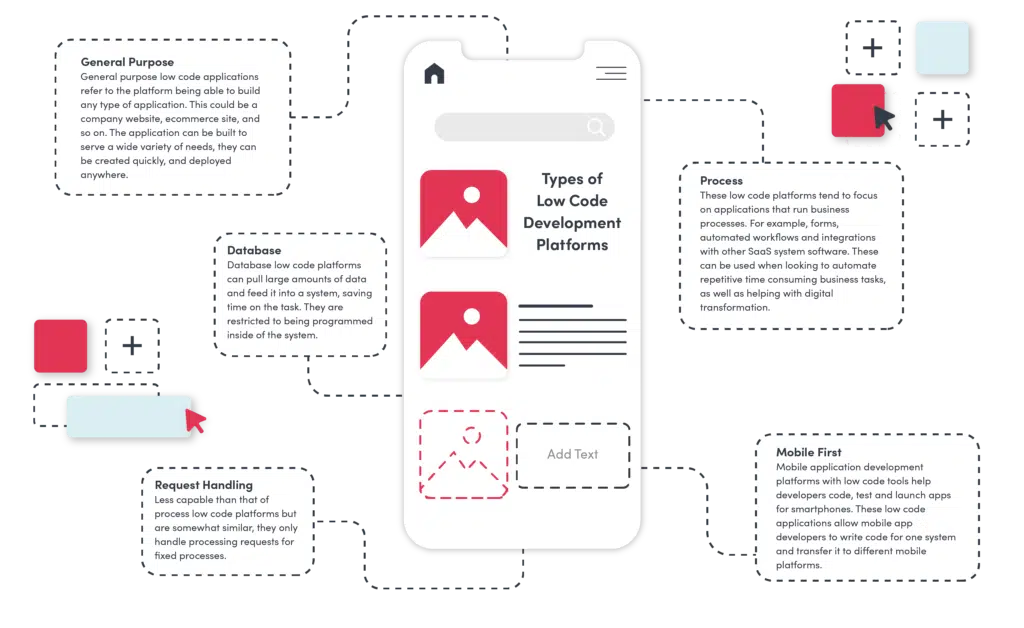Free Info For Selecting Low-Code Platform Recommendations
Free Info For Selecting Low-Code Platform Recommendations
Blog Article
Benefits Of Low-Code Application Development In Terms Of Accessibility For Non-Developers
Low-code development of applications significantly increases accessibility for non-developers, often called "citizen developers," because of a variety of key factors. Intuitive Visual Interfaces:
Drag-and Drop Builders: Low code platforms have drag-and drop interfaces that allow non-developers to create apps without having to write a single line of code. This makes development easier for those with no technical backgrounds.
WYSIWYG Editors: "What You See Is What You Receive" editors allow users to create interfaces and workflows in the same way as the actual product, which makes it easier to comprehend and use.
Simple Logic and Workflow:
Visual Workflow modeling: Users can design business processes and application logic using visual flowcharts. The models are more intuitive to work with than traditional code methods.
Pre-built Logic Components: Low-code platforms often contain pre-built logic components (e.g. conditionsal statements loops, conditional statements) that can be easily configured, reducing the need for complex coding.
Reusable Components & Templates
Libraries of pre-built templates: Numerous low-code platforms have a library of templates for common application types that allow non-programmers to begin with a solid foundation to modify as they need to.
Reusable Widgets And Modules: Users are able to use reused widgets. This allows for a simpler creation and eliminates the requirement for deep understanding.
Guided Development and Tutorials
Step-by -Step Instructions Platforms typically offer tutorials on screen, guiding development paths and other tools to help people who are not developers to create applications.
Interactive Tutorials Interactive and hands-on tutorials let users learn by doing. They can build confidence making use of the platform.
Integration with Existing Tool:
Seamless Integration: Low-code platforms are built to integrate seamlessly with the tools and systems in the business (e.g. the ERP or CRM) that allows non-developers, to create applications that work with current workflows.
APIs Connectors: APIs integrate into apps to facilitate integration. This allows non-developers, with no programming skills, to connect to external services.
Collaboration Features:
Team Collaboration: Features like real-time collaboration workspaces and shared workspaces make it possible for non-developers to effectively collaborate with business analysts, developers and other key stakeholders.
Role-based Access Control: Developers can be assigned specific roles that have appropriate access levels, which ensures they are able to contribute to the development process without compromising security or function.
Automated Testing and Debugging:
Test tools are included: A lot of low-code platforms come with integrated debugging and testing tools. These tools streamline the procedure, making it simple for non-developers to ensure their apps are functioning properly.
Error highlighting: The platform points out problems and offers solutions to help non-developers.
The general rule is that low-code development is able to open up development to a wider audience. This is an important benefit for those who aren't developers. With its visual-friendly tools and experiences, low code platforms enable business owners to actively take part in and manage applications. Follow the top rated the advantage for Low-code Platform for application development for more examples including app development platform, database in azure, jdbc server, rapid app development, ms azure sql, application modernisation, cross platform app dev, app dev platform, low code development platforms, rad application development and more.
Benefits Of Low-Code Application Development In Governance And Security
Low-code applications offer several benefits for cybersecurity and governance, which is crucial to ensure that all apps are well-managed, managed, and compliant throughout their lifecycle. Here are the key benefits: Centralized Governance
Unified Management Console - Low-code platforms provide a central management console to allow administrators to control and supervise every application. This allows for consistent governance throughout the organization.
Role-Based Access Control (RBAC) The majority of these platforms offer robust role-based access control that allows administrators to establish and enforce access rules. Only authorized users will be able to access and modify certain parts of the application.
Compliance and Regulatory Adherence
Many low-code platforms include integrated compliance features. They are designed in accordance with the standards of the industry, regulations and laws (e.g. HIPAA, GDPR). They provide templates and tools to ensure that the applications are compliant with these requirements.
Audit Trails & Logging: Audit trails and logs that are comprehensive can be incorporated to allow organizations to track change in access, and monitor access and conformity.
Increased Security Measures
Data encryption. Low-code platforms usually offer built-in encrypted data during transport and when at rest. This protects sensitive information.
Security Certificates: A lot of low code providers have security certificate (e.g. ISO 27001 and SOC 2) which demonstrate their adherence to strict security standards. They offer an additional security level to their customers.
Automated security updates:
Regular updates and patching Low-code platforms can handle the majority of security patches and updates automatically. They ensure that apps are protected from the latest threats without having developers intervene manually.
Security Monitoring: Continuous security monitoring tools can be integrated to give real-time alerts and information on security problems.
Data Governance
Data Access Policies These systems allow organisations to create data access rules and enforce them, ensuring data is available only to those who have been granted access. They also make sure that the data is used correctly.
Data Masking and Anonymization The built-in tools for masking data and anonymization can help safeguard sensitive data, particularly in the testing and development environment.
Consistent application lifecycle management:
Pipelines for Development and Delivery Low-code platforms often have integrated pipelines for development and delivery pipelines that include security tests. Security is guaranteed throughout the lifecycle.
Version Control: A unified version control system can help manage changes, allowing any changes made to an application to be tracked. If needed, these can be reverted and the integrity of the application maintained.
User Authentication, Authorization and Authorization
Single Sign On (SSO) Supporting single sign-on and other advanced authentication methods reduces the burden of managing users and increases security.
Multi-Factor Authentication (MFA): Many platforms provide built-in support to multi-factor authentication, adding an additional layer of security to access applications.
Monitoring of Policy Enforcement:
Low-code platform often comes with pre-defined policies templates that enable organizations to implement security and governance policies swiftly.
Tools for Monitoring Compliance These tools track and continuously report on compliance status. They help to spot problems and address them in a proactive manner.
Integration with Existing Security Infrastructure:
Seamless Integrate: Low-code platform are designed to seamlessly integrate with the existing security infrastructure and tools, such as identity management tools, SIEMs (Security Information and Event Management Solutions), and firewalls.
API Security: Built-in API security features protect the data of API users, ensure integrity of applications and safe integrations.
Best Practices and Training:
Guided Best Practices : Many platforms offer guidelines and best practices to assist non-developers comply with security standards.
Security Training: A few low-code vendors provide security training and resources that help users understand how to build and maintain secure applications.
Overall, low-code application developers provide a security and governance advantage which allows them to create and manage their apps in a controlled, compliant and secure way. These platforms come with the tools, frameworks and regulatory compliance that are required to safeguard sensitive customer information as well as enforce policies and keep regulatory compliance in check as well as simplifying the management of and oversight over the application development process. Take a look at the most popular Enterprise application development with Low-code Platform hints for website examples including azure sql server, rapid action development, push notifications android, app modernization, rad application development, develop cross platform mobile app, cross platform mobile development, database in azure, database in azure, cloud software applications and more.
Advantages Of Low-Code Application Development In Terms Of Vendor Support And Community
Low-code platforms provide significant benefits in terms of community support and vendor support Both of which are crucial to the successful installation, maintenance and enhancement of applications. Here are some of the main advantages.
Comprehensive Technical Support:
Support Teams: Most platforms using low-code have designated support teams that can help with technical issues as well as troubleshooting and advice.
Certain vendors provide 24/7 support. This is particularly beneficial for multinational companies that have various time zones.
Training and Onboarding
Vendors often provide organized programs for users including tutorials or webinars. They might also offer certificates.
A lot of vendors offer personalized onboarding that helps customers to use the platform efficiently and adapt it to the needs of their customers.
Updates and regular updates:
Continuous Improvement Lowcode platform providers typically regularly release updates that contain new features, improvements to performance and security patches. This helps to ensure that the platform remains current and secure.
Feedback Integration: Many vendors integrate user feedback in their process of development. This ensures that the platform can adapt to the changing requirements and desires of its customers.
Comprehensive Documentation:
Documentation is comprehensive and users have the ability to access a large and well-organized documents, which range in complexity from basic customization to advanced usage.
API References API documentation provides complete API references to help developers connect their low-code platform apps with other systems.
Consulting and Professional Services
Expert Consultation: Vendors frequently provide consulting services to help with planning for strategic purposes as well as design of architecture and complex implementations, ensuring that users can leverage the platform to its maximum potential.
Custom Development Services: Certain companies offer custom development services that allow you to develop specific features or integrations that are not included in the default.
Community Support for the Community
Active User Groups:
Discussion boards and forums Forums and discussion boards: Many platforms that are low-code offer a lively online community where users can ask for help, share solutions and collaborate in finding the most effective techniques.
User Groups and Meetups User Groups and Meetups: Local or virtual groups and meetings offer opportunities to learn, network and sharing experiences.
Collaboration and sharing of knowledge:
Community-Contributed Resources: Users often share templates, modules, and extensions that they have developed, which can be reused or adapted by others, accelerating development and innovation.
Crowdsourced Problem Solving: The collective wisdom and experience of the crowd can be an invaluable source of troubleshooting and figuring out creative solutions for complicated problems.
Learning and Development
Community-Led Training: Many communities organize workshops, training sessions, and webinars. They are often conducted by experienced users who share practical knowledge and advanced techniques.
Online Tutorials: The community members make and share a variety of online tutorials, how-tos, and courses. These resources are made available to everyone.
Feedback and Influence
Product Feedback: Many forums allow users to provide feedback to vendors. This could influence the development of the design of new features or improvements.
Beta Testing Programs: Members of active communities could be able to be part of beta testing programs, giving users early access to brand new features and a voice in determining the future of the platform.
Recognition and Encouragement
A lot of companies offer community recognition programs for community recognition. These programs recognize active community members, and can include MVP programs.
Peer Support: Members of the community typically provide peer support offering their expertise and offering guidance for users who aren't as experienced creating a more collaborative and supportive environment.
Overall the combination of strong vendor support and a vibrant connected community offers a comprehensive support ecosystem for low-code application development. This ensures that users are able to access the resources as well as the expertise and collaboration opportunities required to effectively develop, deploy, and maintain their applications, ultimately enhancing the efficiency and effectiveness of their applications.